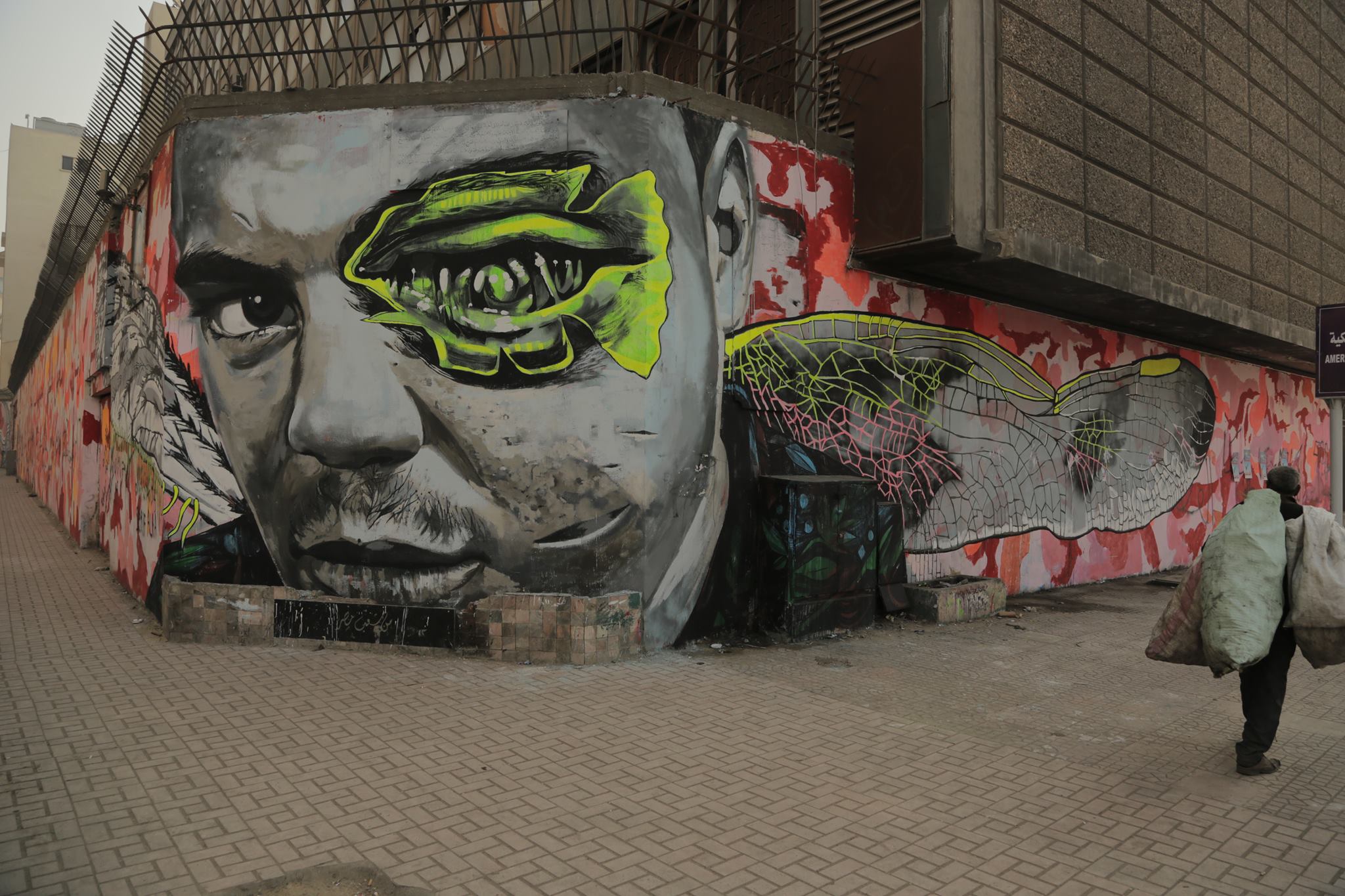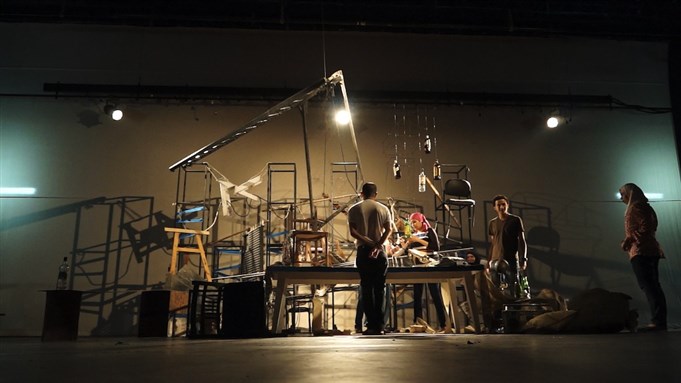Street art has played an important role throughout the Egyptian revolution. As many observers have pointed out, such art is more than mere representation that inspires mobilization. It is that, certainly, but it is also an act of protest in and of itself. It is not only artists who make this claim. With each of their whitewashing campaigns over the last three years, state authorities have also routinely recognized this fact. In anticipation of biennial commemorations of the November 2011 massacres on Mohamed Mahmoud Street, the government of Prime Minister Hazem El-Beblawy passed a law raising punishment for graffiti to four years in prison and an 18,000 USD fine.
Even before the 2011 massacres, Mohamed Mahmoud Street was synonymous with revolutionary street art. Since then, of course, the street has become an open-air gallery of elaborate murals, painted and layered atop of one another. Of the many protest-artists working on Mohamed Mahmoud Street, few are better known than Ammar Abo Bakr. His mural series are unquestionably provocative and level the charge of murder at a number of State powers, including the military and the Ministry of Interior as well as religious institutions, the media and the Muslim Brotherhood.
With the overthrow of President Mohamed Morsi, many street artists retreated from Mohamed Mahmoud Street. But last November, as the military inaugurated a memorial for the Mohamed Mahmoud martyrs in Tahrir Square, protesters and artists returned to mark their dissent. Many of these activists were appalled by the fact that the military was attempting to honor the very people it killed. For Ammar and many others, the botched attempt at official commemorations of state murder evoked the Arabic proverb, “Committing murder, then marching in the funeral procession.”
I spoke with Abo Bakr in late November.

[Abo Bakr Mural, Mohamed Mahmoud Street, image from artist]
SM: Can you tell me about your work on Mohamed Mahmoud Street?
AA: I am currently working on a mural of a military camouflage with a pink tint. I am working on it with a group of course, a large group. Before beginning, we sat together in the street and decided on a few things. First of all, that we do not support Rabaa, pro-Morsi protests, and that we were relieved to have gotten rid of Morsi. We also agreed that we are against the military. I know that the military put Morsi in his position as president in order to use the Brotherhood as an excuse and to scare people, in the same way that Mubarak used the Brotherhood.
So our latest work on Mohamed Mahmoud Street came out of a particular context. There was a major propaganda campaign suggesting that anyone who protested in Downtown Cairo was a supporter of the Muslim Brotherhood. The media was pushing this message all over, trying to scare people and prevent them from protesting.
But we insisted that we would protest, and that our message would have nothing to do with the Brotherhood. The most appropriate form of address in this moment is a vulgar one. There is no other way to speak to the military. Look how crude they were. You build a memorial in Tahrir Square for all the people you killed. Then you gather their families together to commemorate the event. Is there anything more crude and vulgar than that? So on top of the camouflage layer, we wrote the dirtiest phrase we could. It is vulgar, sure. But it is you, not us, who killed people, who imprisoned them, and who committed these crimes. For example yesterday they stooped to condemn people for burning the flag on the memorial. They were appalled that someone set a flag on fire? Who cares about burning a flag when they burn human beings?
I am sorry that we had to write that. But nothing is more vulgar than playing with the memory of the martyrs. The martyr is dead, and should be untouchable—so why do I paint him? Because I am searching for the killer, that’s why. It is not the martyr himself I am concerned with—I put the image of the martyr in the street to disturb the people who murdered him. I want to identify the people who murdered our martyrs, I want to stop them, I want to stop the killing.
SM: You stopped working on Mohamed Mahmoud Street from June 30 until very recently. You were working elsewhere, over on Qasr al-Nil Street. Why did you leave Mohamed Mahmoud and why did you return?
AA: Of course I had to return to Mohamed Mahmoud—it is my job to remind people of the anniversary of the massacres that took place there. I have commemorated both anniversaries here on Mohamed Mahmoud Street. When I returned here in 2012, I drew the gruesome post-mortem images of martyrs, like the photograph of Khaled Said after he was so savagely beaten.
The idea of the anniversary and our very presence on it on 14 November is very crucial. But it is separate from my project on Qasr al-Nil Street. That series is less aggressive than the work on Mohamed Mahmoud. The idea of Qasr al-Nil Street is to develop graffiti and street art as an expressive tool. We are working on more than one level. Besides our political art, I am interested in a local, popular kind—connected to how I know Egypt, which is from below. I lived in a mud house in a rural village for several years and feel a connection to ordinary Egyptians and what they think is beautiful and how they see the world, how they see humanity. And so while we strongly oppose the military and want to mark that stance, we love the people and would also like to present art to the people.
The two causes are tied to one another. We cannot always paint in an aggressive or violent way, and expect to maintain popular support. As an artist, I also want to present something of beauty to people who can see it, see that their streets have beautiful murals and feel joy. Today, in the midst of our revolution, I would not be content to offer something in a gallery. Who goes to a gallery to see art? Maybe you or me, or people willing to pay for it, but nobody else. What about the people for whom we came out to protest? The people we have belonged to since before the revolution? I must take those people into account and to the extent that I can, present something to them as well.
SM: You have painted under the Supreme Council of the Armed Forces, President Morsi and now. How have these different periods of rule been different for you as an artist? For example, have the change in laws affected you?
AA: I do not see them as different. I cannot say, for example, that I painted under “the rule of Morsi” because I did not think of it as “the rule of Morsi.” There is only one enemy, one killer. He has been there all along and he is still there now. They change faces, and people get distracted. And the law? The law does not concern me. There is no law in a fascist state, there is nothing called the judicial process. People expect the judicial process to bring justice for the sake of the martyrs. But who must the Judiciary rely on for bringing cases forward? The Public Prosecutor. And who does the Public Prosecutor’s office depend on? The Interior Ministry. To expect the judicial process to work means hoping murderers will gather evidence against themselves.
SM: What do you see your current role to be as a protest-artist?
AA: I am with the people and I am with the movement in the street as ever. I have no special role, but play a role just like everyone else. As an individual, as Ammar, I can do nothing on my own. I cannot paint a mural in one night. I cannot go at midnight and end up with an entire wall painted by six in the morning. And then there is the energy created by working collectively. Over three years, we have built real trust and developed real expertise together.
As artists, we have strengthened ourselves and developed a strong collective voice. We have the power to shape the picture, but they do not. They have their money to host elections. They can work their media, and they can spend their money on commercials, and all to try to put the revolution in a ballot box. But the revolution will come back every winter. And it will destroy everything they have done, all of it. They return and try to install a constitution, and it falls. And they will try to install a constitution again, and still the revolution will destroy it. Why? The revolution is not a ballot box. The revolution is not politics. The revolution is not a constitution. The revolution is not laws. The revolution must first take back what was taken by those who robbed the country in the first place. And this cannot happen through legal means, since the law was created by a ruling clique of criminals.
SM: Then, what do you mean by ‘the revolution’?
AA: The revolution is people knowing their rights. The revolution is about exposing the thieves and the criminals and the killers, and all that has been hidden since Nasser’s day. It is bringing groups and people closer together. Not in the form of a party—because parties can be easily infiltrated. The revolution is about creating something new. The revolution is this—what is new and innovative. We will decide what the revolution looks like. It will be outside of the old logic, outside of the old boundaries.
Revolution, not institutions, will clean up things. Revolution is everywhere, in every sector of society.
SM: Can you give me an example of this?
AA: The revolution is the students at the Fine Arts College, for instance. The students had been petitioning the Dean for reforms within the College, but were ignored. Recently, the Dean tried to host an exhibition of art works by teaching faculty and he invited the governor and president of the university—he was just putting something on for appearance, whereas in reality the students were neglected. As a sign of opposition, the students demonstrated and blocked the president and governor from going in. They stopped the exhibition. That is the revolution. This form of defiance or even voicing opposition, trying to change things, was unthinkable before the revolution – a student could not even look a professor or the Dean in the eye.
I am just talking to you about the small part of the revolution that I know from my field of work, so imagine similar situations taking place in every sector of society. That is the revolution.
SM: What about the political efforts to bring change?
AA: The revolution has nothing to do with political parties, it has nothing to do with ballot boxes, it has nothing to do with a Committee of Fifty or a Committee of Sixty. It has nothing to do with any of these political things. The revolution is something else entirely.
We are still dealing with the same regime. Mubarak stepped down. The Sharaf government stepped down. Shafiq is gone, and Morsi is gone. And Sisi will be gone too. And the streets will continue.
![[Abo Bakr Mural, Qasr el-Ayni Street, image from Ammar Abo Bakr]](https://kms.jadaliyya.com/Images/357x383xo/AboBakrImage.jpg)














